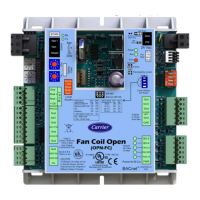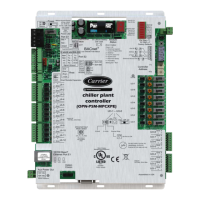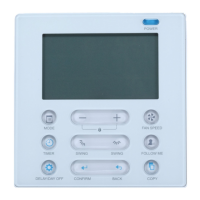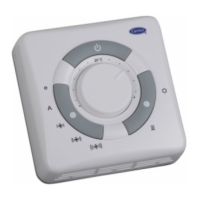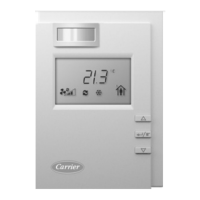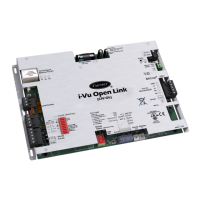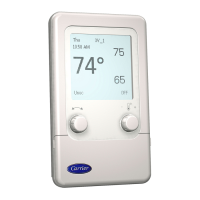2 - COMPOSITION
TERMINAL CCU Controller
J7
(SL)
1 Control of electric heater stage 1
2 Control of electric heater stage 2
3 Electric heater control common terminal
4 Supply air fan control
5 Not used
6 Fan control common terminal
J8
1 24 V AC power supply
2 24 V AC power supply
3 0 V
J9
1 RS485 A or + (Link between controllers for master/slave function)
2 RS485 B or - (Link between controllers for master/slave function)
3 0 V
J10
1 RS485 A or + (Link with CMS or gateway)
2 RS485 B or - (Link with CMS or gateway)
3 0 V
J14
1 + 12 V
2 RS485 A or + (Link with CPY humidier and/or FMA)
3 RS485 B or - (Link with CPY humidier and/or FMA)
4 0 V
J15
(SA)
1 0 V
2 Outdoor temperature sensor (10 K Ω)
3 Outdoor relative humidity sensor (0- 10 V)
4 Raised oor dierential pressure monitoring sensor (0- 10 V)
5
Fan dierential pressure sensor (0-10 V) or target temperature sensor (2-10 V) or percentage required
on external signal (2-10 V)
6 5 V
COM SWITCH
- COM 1: line termination resistance on CMS link (see section 13)
- COM 2: BUS polarisation on master/slave link (see section 12)
2.3 - Batteries
This unit is equipped with a CR 2430 type 3V lithium battery.
- Match the +/- polarity
- The batteries supplied are not rechargeable
Warning : there is a risk of explosion if the battery is replaced
with the wrong type. Dispose of used batteries in accordance
with the instructions. When replacing batteries, make sure the
product is correctly and completely retted.
IMPORTANT for Switzerland: Annex 4.10 to the norm SR
814.013 is applicable to batteries.
Safety guidelines
These instructions must be read carefully and observed. Keep this
manual.
Hazard for children
• Batteries could pose a lethal risk if swallowed. The remote
control and its batteries must be kept out of the reach of
young children. If a child does swallow a battery, seek
medical attention immediately.
• Keep the packaging out of the reach of children. Risk of
suocation!
Risk of injuries and health problems
• If the liquid acid leaks or becomes oxidised, avoid any contact
with the skin, eyes and mucous membranes. In the event of
contact with battery acid, rinse the point of contact
immediately with plenty of clean water and seek medical
attention immediately.
• Batteries should be removed from the unit when they are
spent, or if they are not being used for prolonged periods.
This will prevent damage due to leaks.
• Do not expose the batteries to extreme conditions by placing
them on radiators, for example. Increased risk of leaks!
• The batteries must not be charged, opened, thrown into re
or short-circuited. Risk of explosion!
Battery recycling
• Do not dispose of batteries with the ordinary household
waste. To protect the environment, batteries should be
disposed of in line with the regulations in force.
• Never recharge non-rechargeable batteries. Do not
disassemble batteries. Do not throw them into the re.
• Do not incinerate them.
8
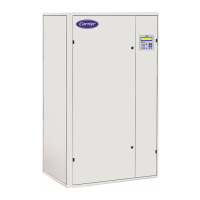
